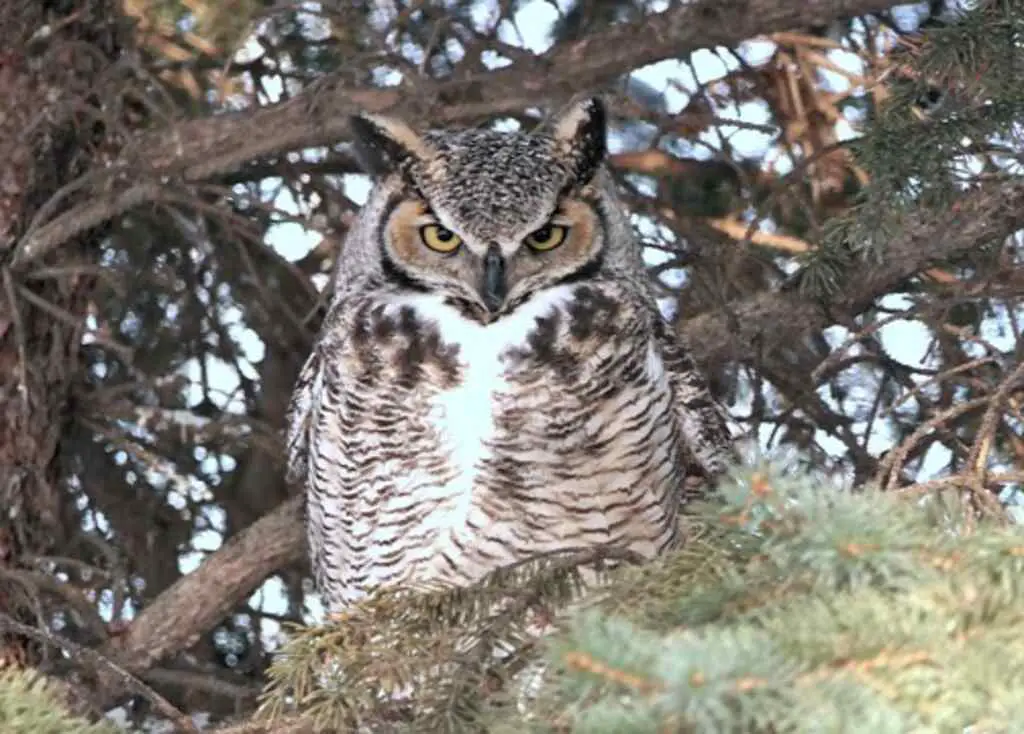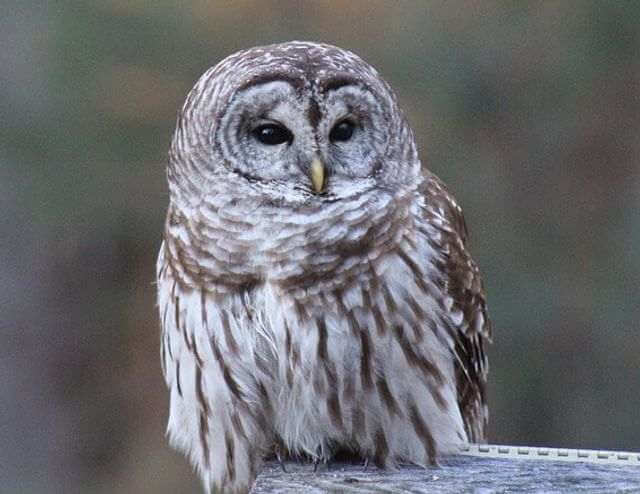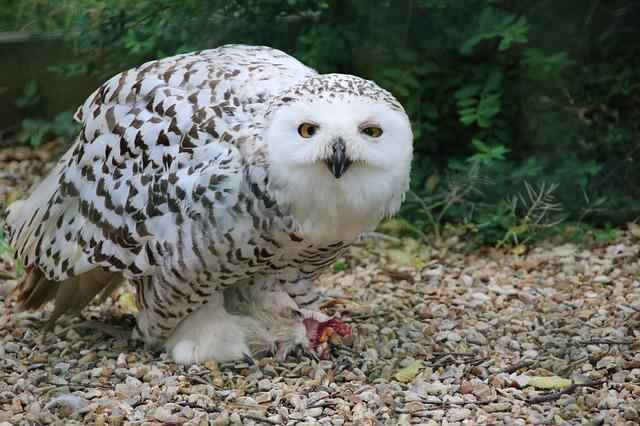In this article, we’ll introduce you to the nine types of owls in Missouri. From the petite Northern Saw-whet Owl to the majestic Great Horned Owl, Missouri boasts a rich diversity of these fascinating birds. Join us as we look into their unique features, habitats, and discover the wonders of Missouri’s owl species.
Table of Contents
Types of Owls in Missouri
Barred Owl
- Length: 16.9-19.7″ in (43-50 cm)
- Weight: 16.6-37.0 oz. (470-1050 g)
- Wingspan: 39.0-43.3″ in (99-110 cm)
- Scientific Name: Strix varia
- Frequency of Occurrence: 5.04% (Statistic by: eBird)
- Where To Find Them: The barred owl is a common bird in Missouri, especially near forests. You can see them at most of the following locations: Southern Great Plains: Niangua Conservation Area, and George Rogers Clark Park.
General Information: The Barred Owl is a large owl found primarily in North America. They have a distribution range that extends from the United States all the way to south of Mexico. They are most commonly found in open woodlands, but can also be found near urban areas and in agricultural areas.
The Barred Owl is mostly a nocturnal bird, but will also forage during the day. They primarily eat small animals, such as squirrels, rodents, chipmunks, but will also eat insects, and carrion. They typically build their nests in tall trees or on high cliffs.
Great Horned Owl

- Length: 17.7-24.8 in (45-63 cm)
- Weight: 32.1-88.2 oz. (910-2500 g)
- Wingspan: 39.8-57.1 in (101-145 cm)
- Scientific Name: Bubo virginianus
- Frequency of Occurrence: 2.07%
- Where To Find Them: The Ozarks: The great horned owl is a common sight in the Ozarks, where they live among the cliffs and cedar trees. They are often seen perched on high trees or poles, watching for prey. The Bootheel: The Bootheel is a great place to see these owls because of its many open fields and woodlands. They can be found hunting during daylight hours, so make sure to go out early in the morning or late at night when they’re most active.
General Information: The great horned owl is a large owl found in most of North America. It is the largest owls in North America and has the widest distribution range of any owl. The great horned owl can be found in all types of forest, including deciduous, mixed, coniferous, and tropical rainforest.
The diet of the great horned owl includes small mammals, birds, and reptiles. They are able to catch prey by flying low to the ground and then pouncing on their prey. They typically nest in tree cavities, but have been known to nest on cliffs and even on human-made structures such as antennas.
Handpicked Related Post: 35 Fun Facts About The Great Horned Owl (Detailed)
Eastern Screech Owl
- Length: 6.3-9.8″ in (16-25 cm)
- Weight: 4.3-8.6 oz. (121-244 g)
- Wingspan: 18.9-24.0″ in (48-61 cm)
- Scientific Name: Megascops asio
- Frequency of Occurrence: 0.3751%
- Where To Find Them: The eastern screech owl is a common sight in many parts of Missouri, especially in wooded areas. They are usually found perched high in trees, and are very active during the night. The best locations to see them include the Boonville and Warrensburg areas, as well as the Mark Twain National Forest.
General Information: Eastern Screech Owl is a medium-sized owl that is found primarily in the eastern United States and southeastern Canada. This owl has a distribution range that includes most of the eastern United States, portions of western Canada, and parts of southern Mexico.
Eastern Screech Owls prefer open habitats with plenty of trees, such as forests and prairies. They are also common in agricultural areas. The owl feeds mainly on small rodents, small animals and other large insects when available. Eastern Screech Owls typically nest in holes, or tree cavities, but they have been known to nest on cliffs and buildings.
Short-eared Owl
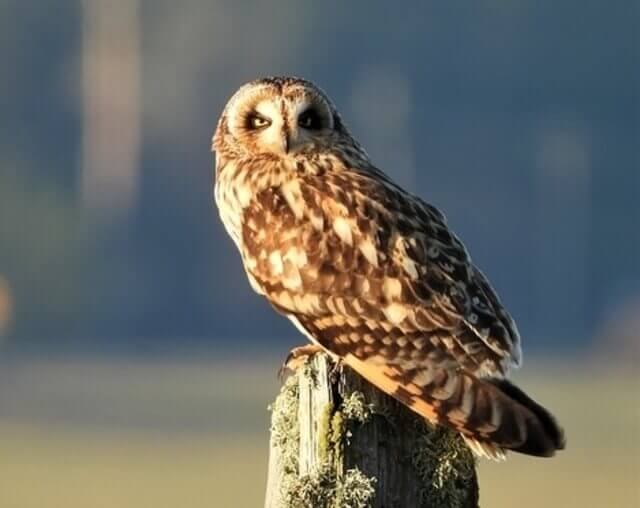
- Length: 13.4-16.9 in (34-43 cm)
- Weight: 7.3-16.8 oz. (206-475 g)
- Wingspan: 33.5-40.5 in (85-103 cm)
- Scientific Name: Asio flammeus
- Frequency of Occurrence: 0.3085%
- Where To Find Them: These owls can be found throughout the state, but some of the best places to view them are in the Ozarks and along the Missouri River.
General Information: The short-eared owl is a medium-sized owl that can be found throughout North America. The distribution range of the short-eared owl includes most of Canada and the United States, except for parts of the southwest and southeast. It prefers wooded areas with plenty of open space near the ground, such as old fields or prairies.
The diet of the short-eared owl consists mostly of small mammals, such as rats and mice, but it will also eat birds and other creatures. Short-eared owls are very territorial and will often build their nests in tall trees or on high cliffs.
Snowy Owl
- Length: 20.5-27.9 in (52-71 cm)
- Weight: 56.4-104.1 oz. (1600-2950 g)
- Wingspan: 49.6-57.1 in (126-145 cm)
- Scientific Name: Bubo scandiacus
- Frequency of Occurrence: 0.0897%
- Where To Find Them: The Ozarks – The Ozarks are home to numerous snowy owls, and they can be seen hunting anywhere from lowlands to high elevations. The Bootheel – The Bootheel is home to several protected areas that are great habitats for snowy owls. These include the Natchez Trace Parkway, Big Creek National Wildlife Refuge, and Harrison Ford National Historic Site. The St. Louis metropolitan region – The St. Louis metropolitan region is home to many parks and other natural areas that provide good habitat for snowy owls.
General Information: The snowy owl is found in many parts of the world, but is most common in North America. In North America, the snowy owl ranges from Alaska to Newfoundland and Labrador. They are also found in the eastern portions of Canada, as well as northern Mexico. The snowy owl is a resident bird in some areas, but migrates to other parts of the world during winter.
The snowy owl inhabits a wide variety of habitats, including tundra, boreal forests, and even urban areas. They are mainly nocturnal birds, but will sometimes forage during the day. Their diet consists mostly of small mammals and birds, but they will also eat insects. The female Snowy Owl forms its nest, by scraping a depression in the ground. There are usually two to eleven eggs per nest and incubation lasts around 32 days.
Handpicked Related Post: 48 Fun Facts About Snowy Owls (with Photos, ID & Info)
Barn Owl
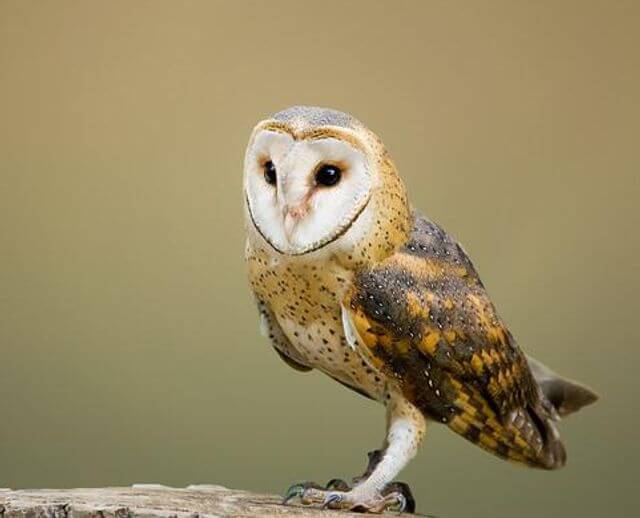
- Length: 12.6-15.8″ in (32-40 cm)
- Weight: 14.1-24.7 oz. (400-700 g)
- Wingspan: 39.4-49.2″ in (100-125 cm)
- Scientific Name: Tyto alba
- Frequency of Occurrence: 0.0824%
- Where To Find Them: They can be found in many locations or spots in Missouri such as the Ozarks, the Bootheel, and parts of the Kansas City metropolitan area.
General Information: Barn Owls are common residents of rural and forested areas throughout North America. The distribution range of this species extends from the Arctic tundra to the tropics, including most of Canada and the United States.
Barn Owls consume a variety of prey, which can include small mammals such as voles, shrews, mice, birds, reptiles, amphibians, and insects. They mainly hunt at night, but will also take advantage of opportunities during the day. Barn Owls typically build their nests in holes or cavities within tall trees or on high ground.
Long-eared Owl
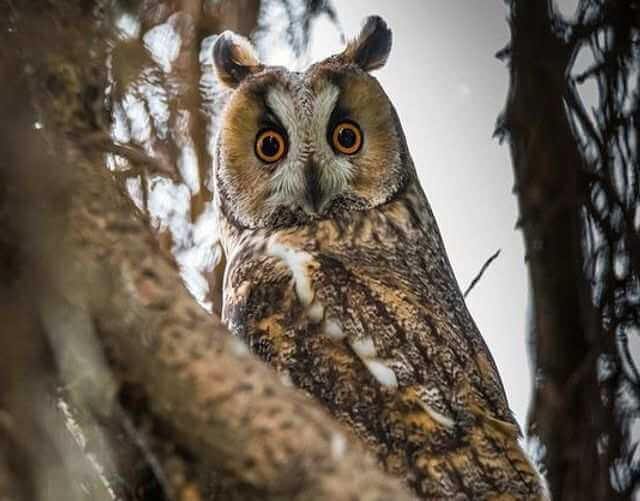
- Length: 13.8-15.8 in (35-40 cm)
- Weight: 7.8-15.3 oz. (220-435 g)
- Wingspan: 35.4-39.4 in (90-100 cm)
- Scientific Name: Asio otus
- Frequency of Occurrence: 0.0213%
- Where To Find Them: They can be found in many locations, but some of the more popular spots are Hartsfield State Airport and The Lost Cave Wildlife Area.
General Information: The Long-eared Owl is a large owl found in North America. The distribution range for the owl includes most of Canada and the United States, as well as much of Central America and South America. The owl is also found in parts of Europe and Asia. They generally inhabit wooded areas, but can also be found near open fields or in suburban areas.
They eat mostly rodents and other small prey, but will also consume small birds, lizards, frogs, snakes and more. They build their nests in tree cavities or often use abandoned crows or raptors nests.
Northern Saw-whet Owl
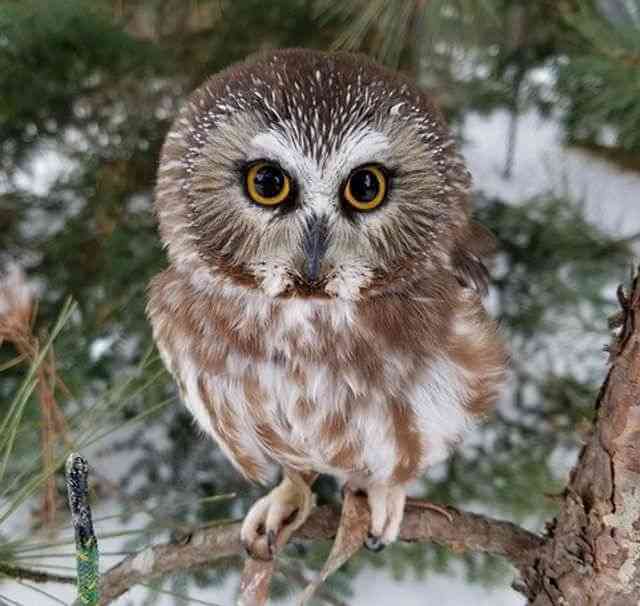
- Length: 7.1-8.3 in (18-21 cm)
- Weight: 2.3-5.3 oz. (65-151 g)
- Wingspan: 16.5-18.9 in (42-48 cm)
- Scientific Name: Aegolius acadicus
- Frequency of Occurrence: 0.0132%
- Where To Find Them: They can be found in many different locations, but some of the more popular spots include the Bootheel and Eastern Plains regions.
General Information: The Northern Saw-whet Owl is a small owl found in the boreal forests of Canada and the United States. Its distribution range extends from the Arctic tundra to the mountains of California. The owl inhabits a variety of habitats, including coniferous, deciduous, and mixed forests. It eats mostly mammals, but will also eat birds and other small prey.
Saw-whet Owls typically nest in large tree cavities, but may also use artificial structures such as old nests or abandoned woodpecker holes. They are monogamous and have one or two eggs per clutch.
Handpicked Related Post: What is the Smallest Owl in North America?
Burrowing Owl
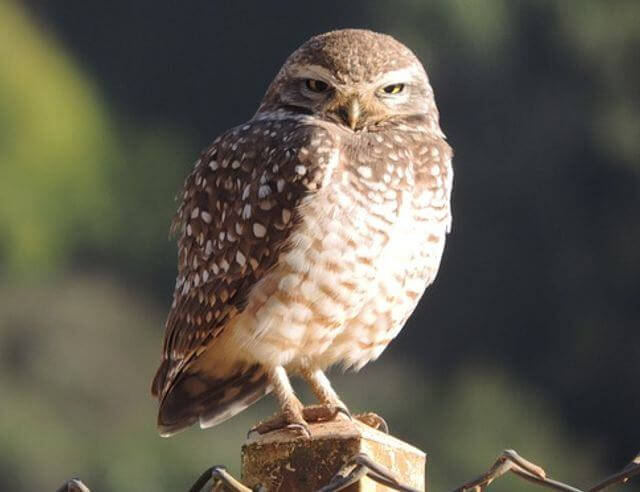
- Length: 7.5-9.8″ in (19-25 cm)
- Weight: 5.3 oz. (150 g)
- Wingspan: 21.6″ in (55 cm)
- Scientific Name: Athene cunicularia
- Frequency of Occurrence: 0.0087%
- Where To Find Them: Burrowing owls are found throughout Missouri, though they tend to prefer moist areas with plenty of tree coverage. These owls can be seen in the Ozarks, the Bootheel, and the Eastern Plains regions.
General Information: The Burrowing Owl is a large owl found in the eastern and central United States. It is the only owl found in the Western Hemisphere that digs its own hole to sleep in. The Burrowing Owl is most commonly seen during the daytime flying through trees and bushes looking for prey. The Burrowing Owl prefers woodlands with plenty of shrubs and insects to eat, but will also frequent open areas where it can hunt.
They mainly hunt small animals such as mice, voles, rabbits, and birds, but have been known to take larger prey like raccoons and squirrels. In winter, they will find shelter underground in abandoned rodent nests or old animal dens. Burrowing Owls are sexually dysmorphic; males are much larger than females.
Handpicked Related Post: Really Cool Burrowing Owl Facts That Will Amaze You!
Related Post: 62 Most Common Backyard Birds in Missouri (Detailed)

